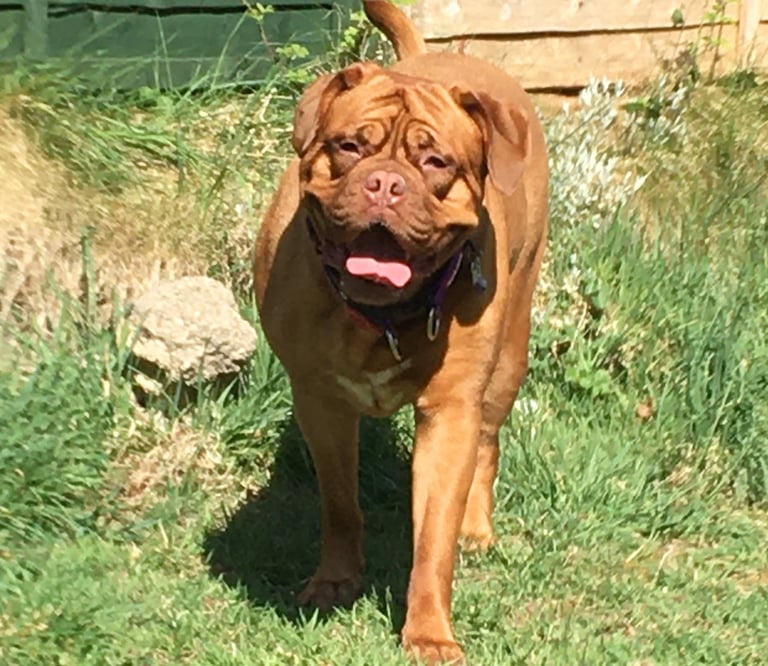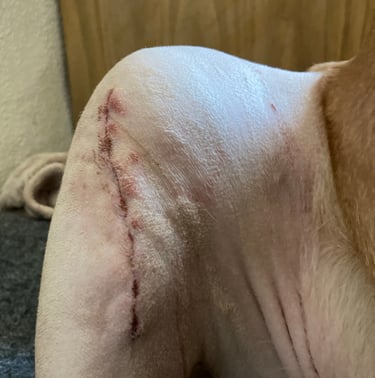Disclosure: Some ads may contain affiliate links. I may earn a commission if you make a purchase, at no extra cost to you.
Cruciate Ligament Disease in Large Breed Dogs: Causes, Symptoms & TPLO Surgery & Recovery
Learn the signs, causes, and treatment options for Cruciate Ligament Disease in large breed dogs. Read our personal TPLO recovery story with Cersei and get helpful tips for supporting your dog through diagnosis and healing.
PET HEALTH
Meo
5/29/20257 min read


Cruciate Ligament Disease in Large Breed Dogs: Causes, Symptoms, and Treatments
Hello friends, and welcome back to Meo’s World!
Today, I want to talk about something that hits very close to home for me—and probably for many of you, too, if you share your life with a big, bouncy dog. We’re diving into Cruciate Ligament Disease (CLD)—what it is, why it happens, how to spot it early, and what you can do to help your pup if they’re diagnosed.
This post is extra personal because my own beloved Cersei, a strong and spirited Dogue De Bordeaux, was diagnosed with Cruciate Ligament Disease and underwent TPLO surgery (Tibial Plateau Levelling Osteotomy) when she was just two and a half years old. It was a journey full of learning, patience, and a lot of love—and if you’re facing something similar, I hope sharing our experience can offer some guidance and support.
What Is Cruciate Ligament Disease?
Cruciate Ligament Disease in dogs is very similar to what humans know as an ACL injury. In dogs, the ligament is called the cranial cruciate ligament (CCL), and it’s one of the key stabilizers of the knee (stifle) joint. When this ligament becomes torn or ruptured, it can lead to pain, inflammation, and instability in the leg.
There are two main types of CCL injuries:
Partial Tear: The ligament is damaged but still intact.
Complete Rupture: The ligament is fully torn, causing the knee joint to become unstable.
Unlike humans, who usually injure their ACL through sports or sudden trauma, dogs—especially large breeds—often suffer ligament breakdown over time due to degeneration and biomechanical stress.
Why Are Large Breed Dogs More Susceptible?
While any dog can develop CLD, large and giant breeds are significantly more prone to it. This is due to a combination of factors:
Size and Weight: Larger dogs put more stress on their joints just by moving around.
Genetics: Some breeds are predisposed to joint and ligament problems.
Conformation: How a dog is built affects how their joints handle stress.
Activity Level: High-energy dogs can put extra wear and tear on their knees, especially during play or sudden movements.
Early Neutering: Some studies suggest that early spaying/neutering may influence bone and joint development, increasing the risk of CCL injuries.
Commonly affected breeds include Labrador Retrievers, Rottweilers, German Shepherds, Boxers, Great Danes and other mastiff-type dogs such as Dogue de Bordeaux.
Cersei’s Story: Our Personal Journey
Cersei had always been a powerhouse—strong, agile, and full of personality. As a large breed dog, I was always mindful of her joints and movement, especially since I occasionally noticed a clicking sound in her hind legs when she got up or stretched. But up until a certain winter’s day, she had never shown any signs of lameness or discomfort. She ran, jumped, and played like any happy, healthy dog.
Then it happened.
One frosty morning, Cersei was playing in the garden—spinning, chasing imaginary critters, and doing her usual joyful zoomies. The ground was frozen and hard, and in a sudden twist while turning, she yelped and came to an abrupt stop. She was immediately completely lame on one back leg—not putting any weight on it at all.
My heart dropped.
We brought her inside, thinking maybe she’d pulled something, but I had a gut feeling this was more serious. A visit with my vet confirmed what they suspected was a complete rupture of her cranial cruciate ligament. The clicking may have been an early warning of joint instability, but the rupture itself was sudden and severe—serious enough to require a specialist referral.
Because of her size and still being very young (just two and a half years old), the knee specialist recommended TPLO surgery (Tibial Plateau Leveling Osteotomy)—a procedure that would stabilize her knee by changing the mechanics of the joint, allowing her to move without relying on the damaged ligament.
It was an emotional rollercoaster—fear, guilt, questions—but I knew we had to do whatever it took to give Cersei her quality of life back. We moved forward with the surgery, and that decision turned out to be one of the best we’ve ever made.
Everything moved quickly. She had her X-rays, diagnosis, and surgery all in the same vet visit. It was a long, emotional day, but having it all done at once meant she didn’t have to go through repeated stress or wait in pain for answers. The vet team was amazing—efficient, compassionate, and clear about what to expect.
Recognizing the Signs of Cruciate Ligament Disease
Early detection makes a big difference. Keep an eye out for:
Limping or lameness, especially after activity
Difficulty rising from lying down
Stiffness after resting
Swelling around the knee
Reluctance to play, jump, or climb stairs
"Toe-touching" gait – where the dog barely uses the affected leg
That’s why it’s important to trust your gut if you notice anything off with your dog’s movements.
Diagnosing CLD
Diagnosis typically involves:
Physical Exam: The vet will check for pain, instability, and swelling.
Drawer Test or Tibial Thrust Test: Manual manipulations that check for ligament integrity.
X-rays: To rule out other conditions like fractures or hip dysplasia.
MRI or CT Scan: In complex cases, especially if multiple joints are affected.
Treatment Options: Surgical and Non-Surgical
Conservative Management (For partial tears or low-risk dogs)
Weight management
Anti-inflammatory medications (NSAIDs)
Joint supplements (glucosamine, chondroitin, Omega-3s)
Physical therapy
Restricted activity and rest
This approach can help some small dogs or dogs with partial tears. However, for large breeds, conservative management often isn’t enough, especially if the ligament is fully torn.
Surgical Options
TPLO (Tibial Plateau Leveling Osteotomy):
Alters the mechanics of the knee so the ligament is no longer necessary.
Ideal for large, active dogs.
Shorter recovery compared to other surgeries.
This is what we chose for Cersei, and it was a game changer!
TTA (Tibial Tuberosity Advancement):
Another mechanical solution that changes how the knee functions.
Suitable for dogs with a specific tibial angle.
Extracapsular Repair:
Involves placing a suture outside the joint to mimic the ligament.
Less invasive, but often not durable enough for large or active dogs.
What Recovery Looks Like (Cersei’s Post-Op Journey)
Cersei’s recovery from TPLO surgery was a major journey—but one that we took step by step, with a lot of love and a solid plan.
When Cersei came home, she was understandably groggy and sore, but her brave spirit never wavered. She came home with pain relief and antibiotics. We set up a quiet, cozy recovery space so she could rest safely without the temptation to move too much.
Her activity was strictly limited—no stairs, no play, and absolutely no jumping. She was only allowed short potty breaks on a leash, just a few steps at a time. Those early days were all about keeping her calm, clean, and comfortable, and making sure she had everything she needed within reach.
I won’t sugarcoat it—managing a large dog on strict rest isn’t easy, especially when they’re used to being active. But we got into a rhythm with careful routine, enrichment toys, and lots of cuddles. It helped that Cersei seemed to understand she needed to take it slow; she really was amazing.
The first couple of weeks were the hardest, but as we moved into the next phase—gradually increasing controlled movement—her strength and confidence began to return. We followed the vet’s post-op protocol closely, and by the 12-week mark, she was walking smoothly, without a trace of her old limp.
Watching her heal and thrive after surgery was one of the most rewarding parts of our journey together.
How You Can Support Your Dog
If your dog is diagnosed with CLD, know this: you are not alone, and your pup can absolutely live a happy, pain-free life.
Here’s how you can help:
Educate yourself. Ask questions and explore treatment options.
Keep your dog at a healthy weight. Less stress on joints = less pain.
Consider joint supplements (but check with your vet first).
Follow post-op instructions to the letter—recovery takes time.
Invest in physical therapy if possible—it makes a huge difference.
Be patient and positive. Your dog will take their cues from you.
TPLO Recovery FAQs
How long is TPLO recovery?
Full recovery from TPLO surgery typically takes 8 to 12 weeks, though this can vary depending on the dog’s age, size, and overall health. Most dogs start to walk more comfortably around 2 to 4 weeks post-op, but strict rest is crucial in the early stages.
Can dogs walk after TPLO surgery?
Yes, but very limited. In the first few days after surgery, dogs are usually able to walk short distances for potty breaks only, always on a leash. Gradual, controlled exercise is introduced based on your vet's guidance.
What kind of physical therapy helps after TPLO?
Gentle, vet-approved physical therapy can include:
Passive range of motion exercises
Slow leash walks
Underwater treadmill therapy
Balance and weight-shifting exercises
Always follow your vet or rehab therapist’s plan, as doing too much too soon can cause setbacks.
When can my dog return to normal activity?
With proper healing, most dogs can return to normal, off-leash activity by around 12–16 weeks post-surgery, though some may need longer. Your vet will confirm when it’s safe to resume play and exercise.
Is TPLO surgery worth it?
For large, active dogs with a full cruciate rupture, TPLO is often the most effective long-term solution. While the recovery takes time and care, most dogs regain excellent function and quality of life—just like Cersei did.
Disclaimer:
The information shared in this blog is based on personal experience and general knowledge. It is not intended to replace professional veterinary advice, diagnosis, or treatment. Always consult your veterinarian for guidance specific to your dog's health and medical needs.
Final Thoughts from Meo’s World
Cruciate Ligament Disease can feel like a major blow, especially when it affects a young, active dog like Cersei. But with the right knowledge and care, it’s entirely manageable.
Watching Cersei bounce around again—chasing butterflies through the grass and curling up beside me at night—was all the proof I needed that these dogs are strong, resilient, and so worth fighting for.
If you’re going through this journey, feel free to reach out by email or leave a comment. I’m always happy to chat, share more about our experience, or just listen.
Until next time, give your furry friends a big hug from me.


©Meo's World
©Meo's World
Meo's world
<--Awin verification 001-->
Bark
Fetch
meosworld@yahoo.com
© Meo's World 2025. All rights reserved.
